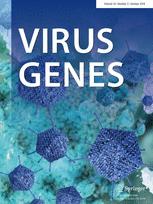Ver ítem
- xmlui.general.dspace_homeCentros e Institutos de InvestigaciónCIAP. Centro de Investigaciones AgropecuariasInstituto de Patología VegetalArtículos científicosxmlui.ArtifactBrowser.ItemViewer.trail
- Inicio
- Centros e Institutos de Investigación
- CIAP. Centro de Investigaciones Agropecuarias
- Instituto de Patología Vegetal
- Artículos científicos
- Ver ítem
Sequencing of two Sunflower chlorotic mottle virus isolates obtained from different natural hosts shed light on its evolutionary history
Resumen
Sunflower chlorotic mottle virus (SuCMoV), the most prevalent virus of sunflower in Argentina, was reported naturally infecting not only sunflower but also weeds. To understand SuCMoV evolution and improve the knowledge on its variability, the complete genomic sequences of two SuCMoV isolates collected from Dipsacus fullonum (-dip) and Ibicella lutea (-ibi) were determined from three overlapping cDNA clones and subjected to phylogenetic and recombination
[ver mas...]
Sunflower chlorotic mottle virus (SuCMoV), the most prevalent virus of sunflower in Argentina, was reported naturally infecting not only sunflower but also weeds. To understand SuCMoV evolution and improve the knowledge on its variability, the complete genomic sequences of two SuCMoV isolates collected from Dipsacus fullonum (-dip) and Ibicella lutea (-ibi) were determined from three overlapping cDNA clones and subjected to phylogenetic and recombination analyses. SuCMoV-dip and -ibi genomes were 9,953-nucleotides (nt) long; their sequences contained an open reading frame of 9,561 nucleotides, which encoded a polyprotein of 3,187 amino acids flanked by a 5′-noncoding region (NCR) of 135 nt and a 3′-NCR of 257 nt. SuCMoV-dip and -ibi genome nucleotide sequences were 90.9 identical and displayed 90 and 94.6 % identity to that of SuCMoV-C, and 90.8 and 91.4 % identity to that of SuCMoV-CRS, respectively. P1 of SuCMoV-dip and -ibi was 3-nt longer than that of SuCMoV-CRS, but 12-nt shorter than that of SuCMoV-C. Two recombination events were detected in SuCMoV genome and the analysis of dN/dS ratio among SuCMoV complete sequences showed that the genomic regions are under different evolutionary constraints, suggesting that SuCMoV evolution would be conservative. Our findings provide evidence that mutation and recombination would have played important roles in the evolutionary history of SuCMoV.
[Cerrar]

Fuente
Virus genes 46 (1) : 105–110. (February 2013)
Fecha
2013-02
Editorial
Springer
ISSN
0920-8569
1572-994X (Online)
1572-994X (Online)
Formato
pdf
Tipo de documento
artículo
Palabras Claves
Derechos de acceso
Restringido
 Excepto donde se diga explicitamente, este item se publica bajo la siguiente descripción: Creative Commons Attribution-NonCommercial-ShareAlike 2.5 Unported (CC BY-NC-SA 2.5)
Excepto donde se diga explicitamente, este item se publica bajo la siguiente descripción: Creative Commons Attribution-NonCommercial-ShareAlike 2.5 Unported (CC BY-NC-SA 2.5)

